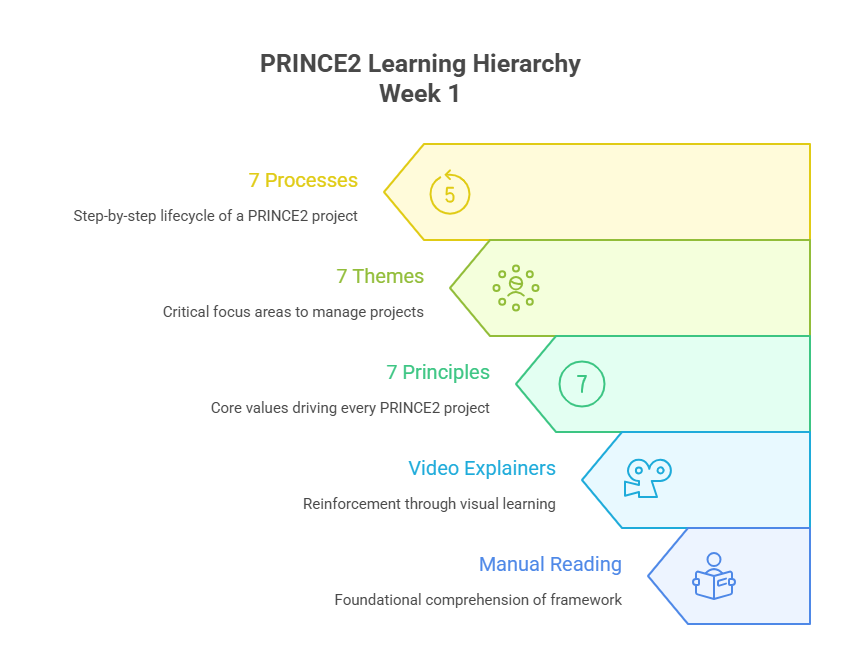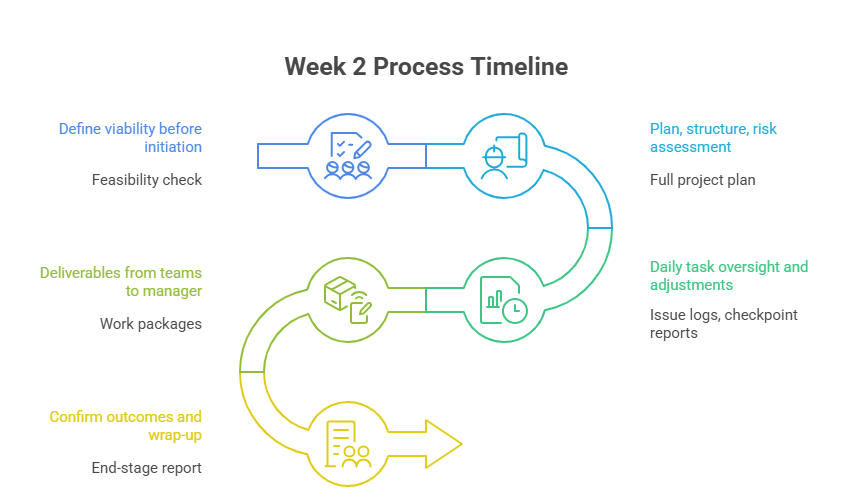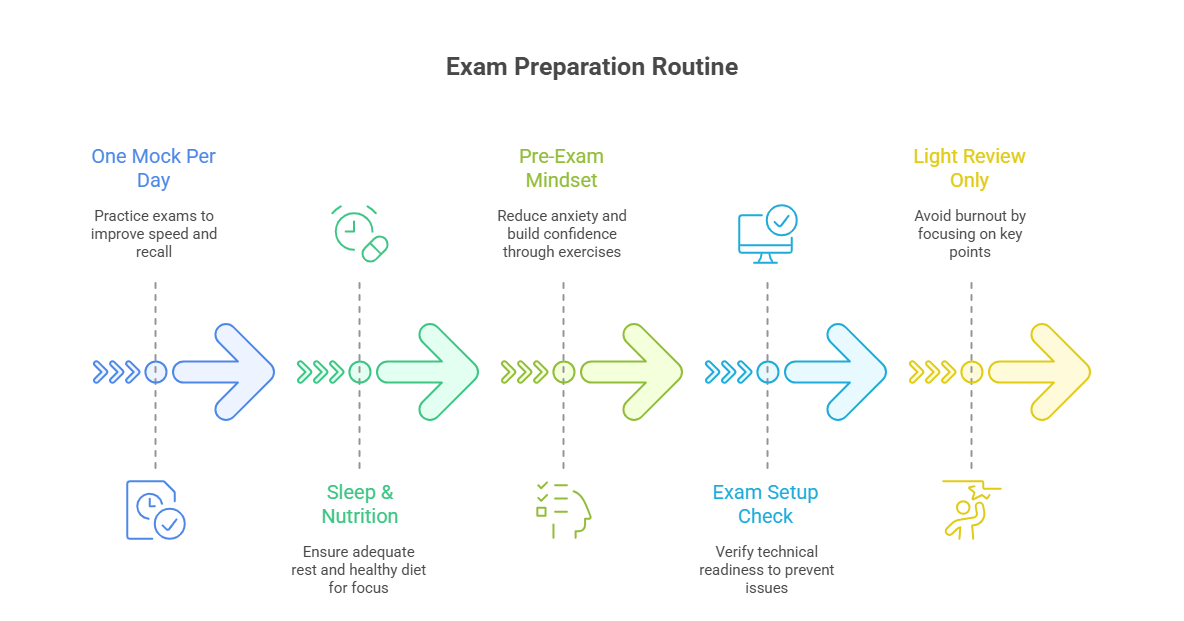Detailed Study Plan for PRINCE2 Certification: 4 Weeks to Exam Success
Whether you're aiming to break into project management or level up your credentials in a competitive job market, the PRINCE2 certification stands out as a globally recognized standard. But passing the exam isn’t just about memorization—it’s about strategic preparation, smart tools, and replicable systems that align with how the exam is structured. This 4-week PRINCE2 study plan is designed to guide you step-by-step, whether you’re targeting Foundation, Practitioner, or both certifications.
Each week is engineered with proven learning techniques, active recall, real-world scenarios, and test-aligned practice questions. You won’t just be reading theory—you’ll be thinking like a PRINCE2 project manager. If you're planning to train through a structured, outcome-driven pathway, check out APMIC’s PRINCE2-Based Project Management Certification Program—complete with a scenario builder, exam bank, and full roadmap aligned with this 4-week plan.
Week 1 – Foundation Principles & Terminology
Read Manual, Watch Explainers, Use Flashcards
Start Week 1 by immersing yourself in the official PRINCE2 manual. Don’t passively read—annotate key terms, create visual summaries, and match content with video explainers on platforms like YouTube or APMIC’s learning portal. Aim to cover 2–3 chapters per day, prioritizing understanding structure over memorization. Once you've covered a section, immediately reinforce it using digital flashcards like Anki or Quizlet.
Break each session into focused 25-minute sprints (Pomodoro method) and close each day with a rapid-fire review using your flashcards. By the end of the week, you should be able to explain the 7 principles without notes and recognize their interplay within project stages.
Key Focus Areas: Principles, Themes, Processes
Week 1 is about foundational fluency. Focus intensely on:
The 7 Principles: Understand how each principle applies to real-life project environments. For example, “Continued Business Justification” isn’t a concept—it’s a decision gate you’ll use in every PRINCE2 scenario.
The 7 Themes: Learn how business case, organization, quality, plans, risk, change, and progress all feed into control and delivery. Don’t just memorize—connect them to decisions in a project’s lifecycle.
The 7 Processes: Grasp the high-level flow of “Starting Up a Project” through “Closing a Project.” Know who is responsible, what gets produced, and which themes interact at each stage.
Break this into action:
Create a mind map connecting all 7 principles to themes and processes.
Use color-coded cues (e.g., blue for processes, red for principles) when reviewing materials.
Build “If X, then Y” flashcard prompts. Example: If the project board withdraws approval, which principle is being enforced?
By Friday, simulate short scenario questions (5–7 per day). Use the manual’s glossary to sharpen technical accuracy. Your goal: achieve 80%+ accuracy on flashcard drills and be able to verbalize how PRINCE2 creates a controlled project environment.
Week 2 – Process Model Deep Dive
Each Process, Inputs/Outputs, Roles
Now that you’ve built a base, Week 2 dives into the PRINCE2 process model—the actionable core of the method. This is where most Foundation and Practitioner candidates lose marks, so the goal is total fluency. Each of the 7 processes—from “Starting Up a Project” to “Closing a Project”—has defined inputs, outputs, and role responsibilities. Begin by creating a spreadsheet that tracks:
Process name
Purpose statement (from the manual)
Inputs and outputs
Who’s accountable (Project Board, Project Manager, Team Manager)
Themes involved
Use APMIC’s scenario builder or case examples to apply this knowledge. For example, when planning a stage, understand not just what’s produced—but who signs off, when it loops back, and how it impacts other themes like quality or risk.
Spend each day covering one process in depth. By Sunday, you should be able to flowchart the full PRINCE2 lifecycle without reference.
Practice Questions on Scenarios
To pass Practitioner-level questions, it’s not enough to know the model—you must interpret and apply it. Use scenario-based MCQs and multi-select questions aligned with each process. Focus on identifying:
Which process is being described (based on activity verbs and decision points)
What action is most appropriate at a given stage
Who is responsible for escalation or resolution
Build familiarity with trigger phrases. If a scenario mentions “creating the project plan,” it likely links to “Initiating a Project.” If it mentions “project board deciding to continue,” that’s “Directing a Project.”
Daily tasks:
Do 10–15 scenario-based questions with a 70%+ target.
Write out explanations for incorrect answers—don’t just review the correct option.
Flag weak areas and tie them back to the Themes and Principles from Week 1.
By the end of Week 2, you should not only recognize each process but confidently explain its start and end triggers, the documents produced, and the stakeholders involved. This knowledge is what transforms passive learners into PRINCE2-certified professionals.
Week 3 – Practitioner-Level Practice
Take Mock Exams Under Timed Conditions
Week 3 is about stress-testing your knowledge in a real exam environment. Start by selecting a reputable mock test—preferably from APMIC’s PRINCE2 exam bank or another accredited provider. These mocks are built to simulate question structure, difficulty, and timing. Set a timer for 2.5 hours (Practitioner) or 1 hour (Foundation) and complete the exam without pausing or referring to notes.
Aim to replicate the testing environment:
No distractions
Paper-based or onscreen as per your exam format
Use only the PRINCE2 manual, as you would during the real exam
Once complete, don’t just check your score—analyze every wrong answer. Create a “missed question log” spreadsheet that includes:
Topic area
Why the answer was wrong
The correct concept or process
A reworded scenario for practice
You’re aiming to spot pattern weaknesses—e.g., always misjudging who approves the stage plan, or confusing “Managing Product Delivery” with “Controlling a Stage.”
Review Answer Keys and Retake Missed Domains
Once you've finished your first two full mocks, start targeting specific low-performing domains. These could be:
Processes you consistently misidentify
Incorrect assumptions about roles and responsibilities
Misapplied principles (e.g., applying “Manage by Exception” when not appropriate)
Use this data to construct mini-quizzes focused on weak zones. For instance, if you missed several “Closing a Project” questions, dedicate a session to reviewing its triggers, outputs, and responsible roles. Rewatch training clips, update flashcards, and write out your own scenario using that process.
Mid-week, take another full timed mock exam and compare performance. Your accuracy rate should now exceed 75% minimum—80%+ if you’re targeting Practitioner.
Daily system for Week 3:
Monday–Wednesday: 1 mock + 2 domain reviews
Thursday–Friday: Focus on role confusion and scenario misreads
Saturday–Sunday: Take another mock, review all missed answers
By the end of this week, your brain should be conditioned to interpret questions through the lens of PRINCE2 logic—not just textbook memory. That mindset shift is what allows you to walk into the exam room prepared, focused, and certified-ready.
| Task | Purpose | Tool/Method |
|---|---|---|
| Mock Exams | Simulate actual exam timing, difficulty, and mental endurance to build confidence under pressure. | Use APMIC’s official exam bank with a stopwatch or timed browser plugin. |
| Answer Review | Identify incorrect logic, reinforce correct process application, and close knowledge gaps efficiently. | Build a “missed question log” in Google Sheets or Notion to track errors and explanations. |
| Score Tracker | Visualize your performance trends and pinpoint fluctuations across different process areas. | Create a spreadsheet with date, mock title, score %, and topic breakdown. |
| Weak Area Focus | Target specific processes or themes you consistently miss in mocks and reinforce them deeply. | Use mini-quizzes, revisit flashcards, and redo select scenario questions. |
| Manual Navigation | Train yourself to quickly find sections in the PRINCE2 manual during the open-book Practitioner exam. | Add colored sticky tabs, practice lookup drills, and memorize keyword locations. |
Week 4 – Final Polishing and Exam Strategy
One Full Mock Per Day
Week 4 is your execution sprint—no new content, just reinforcement, simulation, and mastery. Begin each day with a full-length mock exam under actual time constraints. Use only your official PRINCE2 manual, even if you already know the answer. This will build speed and manual navigation fluency, especially critical for Practitioner-level questions.
Your aim is consistency, not perfection. If your scores vary widely, analyze the timing:
Are you rushing the first half and burning out?
Are you running out of time on long scenarios?
Do you misread questions due to fatigue?
Build a score log and Use the data to adjust pacing and focus. Final exam success is 60% knowledge and 40% mental agility.
Sleep, Nutrition, and Mental Readiness
Don’t ignore your body. High cognitive performance depends on consistent rest, brain fuel, and confidence calibration. Here’s your checklist:
Sleep: Aim for 7.5+ hours each night, especially the night before the exam. Sleep consolidation helps embed complex processes and reduces cognitive fatigue.
Hydration and Fuel: Eat protein-rich meals before study sessions. On exam day, avoid sugar spikes—opt for sustained energy sources like oats, eggs, and nuts.
Mindset: Use pre-exam routines to reduce anxiety and sharpen focus. 10-minute breathing exercises, journaling your readiness, or reviewing high-scorers’ testimonials can help lock in a winning mindset.
Final prep tips:
Don't study the day before. Instead, lightly review flashcards, scan process diagrams, and reaffirm what you know.
Double-check your test center or online exam setup 48 hours ahead.
Pack a checklist: PRINCE2 manual (non-marked), ID, confirmation email, water bottle, analog watch.
This week is where certification becomes inevitable. You’ve layered principles, process fluency, exam conditioning, and psychological readiness. You’re not just taking an exam—you’re stepping into a PRINCE2-certified mindset built to lead with control and clarity.
Tracking Progress & Staying Consistent
Study Logs, Reward Systems, Accountability Partners
No matter how great your materials are, inconsistency kills momentum. This week-by-week system only delivers results if you stay locked in. That means monitoring your progress daily, building in micro-rewards, and creating structures that hold you accountable when motivation dips.
Start by creating a study tracker in Google Sheets or Notion. Each row should include:
Date
Topics covered
Hours studied
Practice questions attempted
Score on mock/tests
Notes or obstacles encountered
Color-code your entries: green for days you hit targets, red for gaps, yellow for partial progress. Over 4 weeks, this gives you a visual map of your consistency—and highlights weak zones before they become failures.
Next, set up a reward system. For example:
After 5 straight study days → one guilt-free evening off
After a full mock exam → favorite snack, movie, or rest day
After 80%+ in two mocks → small purchase or celebration
It may sound small, but positive reinforcement trains your brain to associate progress with motivation. It works—and elite certification earners use it daily.
Leveraging Peer Support and Community
Solo study is risky. You need a feedback loop. Find or form a PRINCE2 study group—online forums, LinkedIn circles, Reddit threads, or APMIC’s student Slack. If you’re taking the course via APMIC, their private group includes:
Weekly check-in prompts
Shared question banks
Progress shoutouts
Live scenario walkthroughs
Even if you’re introverted, having someone else who knows your target date creates external accountability. Better yet, recruit a colleague or friend to act as your accountability partner. Share weekly goals via voice notes, screenshots, or calendar check-ins.
Finally, track qualitative wins:
“I answered all ‘Risk’ theme questions correctly today”
“I finally understood the flow between processes 5 and 6”
“I reviewed all Practitioner errors from last week”
These micro-wins fuel consistency. You’re not aiming for perfection—you’re building a system that keeps you on track without burnout.
Success in PRINCE2 certification doesn’t come from occasional intensity. It comes from sustained, structured momentum. Use data, community, and rewards to keep that engine running.
| System | Function | Tool/Format |
|---|---|---|
| Study Log | Track daily study time, topics covered, quiz scores, and learning milestones to maintain consistency. | Use Notion, Google Sheets, or Excel with columns for date, hours, topics, and notes. |
| Reward System | Boost motivation by pairing achievements with small, meaningful incentives that reinforce habits. | Create a point system or milestone chart with pre-set rewards (snacks, breaks, purchases). |
| Accountability Partner | Establish external motivation through regular check-ins and shared goals with another learner. | Partner with a colleague, join APMIC’s student Slack group, or schedule weekly progress calls. |
| Progress Visualization | Identify patterns, gaps, or burnout risks with visual tracking to guide adjustments in pacing. | Color-code your tracker (green/yellow/red), add graphs for score progression or hours studied. |
| Milestone Wins | Reinforce forward motion by celebrating small wins like completing modules or passing mock exams. | Use weekly goal sheets or a checklist format that marks off completed actions visually. |
Your Success Path Through APMIC’s PRINCE2-Based Program
If you’re looking for a structured, expert-backed path to certification, APMIC’s PRINCE2-Based Project Management Certification Program is the most direct route to exam success. Built around the official PRINCE2 framework, this program integrates exam-aligned lessons, interactive tools, and real-world case scenarios that go beyond just textbook learning.
This isn’t just theory—it’s a conversion system designed to make sure you pass and apply your knowledge confidently on the job.
What's Included in the Program
The APMIC certification includes:
A 4-week guided learning calendar, perfectly synced with this study plan
200+ scenario-based practice questions covering Foundation and Practitioner levels
A scenario builder that mirrors actual case-based exam formats
Flashcards, explainer videos, and manual navigation drills
Weekly mock exam challenges with score tracking
Live instructor feedback and peer comparison analytics
You also get access to a members-only cohort group, where certified mentors answer your questions, troubleshoot process confusion, and provide feedback on mock exam performance.
Designed for Working Professionals
APMIC’s program is built for project managers, analysts, coordinators, and career switchers who are balancing prep with work. You get:
Fully self-paced modules
Mobile and desktop access
Study pacing reminders via email or SMS
Completion certificates to track milestones
Whether you're aiming to pass both PRINCE2 levels in one go or starting with Foundation and leveling up, the program adapts to your path. You can start anytime, and each tool inside is calibrated to help you apply, not just memorize.
From Learning to Certification
By the time you complete the program, you’ll have:
Taken 6+ full mock exams
Reviewed 50+ scenario-based questions
Practiced using the PRINCE2 manual under pressure
Mastered every process, principle, and theme inside the methodology
Built the confidence and clarity to walk into the exam and walk out certified
If you're serious about results, APMIC’s PRINCE2-Based Project Management Certification isn’t just an option—it’s the launchpad.
Frequently Asked Questions
-
The PRINCE2 Foundation certification verifies your understanding of the method’s core principles, themes, and processes. It focuses on terminology, framework structure, and general awareness of how projects operate within PRINCE2 methodology. The Practitioner level, however, tests your ability to apply PRINCE2 principles in real-world scenarios. You’re expected to interpret case studies, identify relevant processes, and determine how best to apply the methodology. In short: Foundation is knowledge-based, while Practitioner is application-based. Most professionals pursue both levels together to build a complete skillset and maximize job eligibility. APMIC’s PRINCE2-Based Certification prepares you for both, with scenario practice and manual navigation tools.
-
With a structured approach, 4 weeks of focused study is sufficient to prepare for both the Foundation and Practitioner exams. The key is not the total hours, but how you organize and reinforce your study. A well-designed weekly schedule—like APMIC’s 4-week calendar—integrates theory, mock exams, and scenario practice efficiently. Most professionals spend 60–80 total hours preparing across both levels. Foundation may only require 25–30 hours if you have prior project experience, while Practitioner requires deeper case analysis. Daily study consistency and exam-style practice questions are far more effective than cramming at the last minute.
-
Yes, both PRINCE2 Foundation and Practitioner exams can be taken online through accredited testing bodies like PeopleCert. The Foundation exam is closed book, meaning you cannot use any reference materials. The Practitioner exam is open book, allowing use of the official PRINCE2 manual only—no notes, bookmarks, or annotations are allowed. Online exams are proctored via webcam and screen monitoring to ensure integrity. APMIC’s certification program includes training on how to navigate the PRINCE2 manual efficiently under exam conditions so you can maximize its utility during the open-book Practitioner test.
-
PRINCE2-certified professionals are qualified for roles such as Project Coordinator, Project Manager, Program Administrator, PMO Analyst, and Business Project Lead, especially within government and regulated sectors. Many multinational companies in the UK, EU, and Commonwealth countries treat PRINCE2 as a baseline qualification. It also increases eligibility for contractor and freelance PM roles. Combined with experience or complementary certifications (like Agile or ITIL), it can open doors to higher-tier roles like Senior Project Manager or Transformation Lead. APMIC’s program also emphasizes post-certification job planning with resume templates and career pathway support.
-
The Foundation exam includes 60 multiple-choice questions, and you need at least 55% (33 correct answers) to pass. You’ll have 60 minutes, and the exam is closed book. The Practitioner exam includes 68 scenario-based objective testing questions, and the pass mark is 55% (38 correct answers). You’ll have 2.5 hours (150 minutes), and it’s open book, limited to the official manual. The exam layout tests your ability to interpret scenarios, identify roles, and apply principles and themes to real-world decisions. APMIC includes timed mock exams structured exactly like the official format.
-
No prior experience is required to take the PRINCE2 Foundation exam, making it suitable for entry-level professionals and recent graduates. However, the Practitioner level assumes a baseline familiarity with project environments. While experience isn’t mandatory, it does help when analyzing scenarios and making judgment calls during the exam. If you're new to project management, APMIC’s PRINCE2-Based Program offers a step-by-step primer, combining real-world context with training tools that build from the ground up. This makes it accessible even if you’re transitioning from other fields like operations, IT, marketing, or finance.
-
The PRINCE2 Foundation certification is valid for life—you do not need to renew it. However, the PRINCE2 Practitioner certification is valid for three years. To maintain your Practitioner status, you can either retake the exam before it expires or subscribe to MyAxelos and log continuing professional development (CPD) points over that period. APMIC provides guidance on renewal options, CPD strategies, and how to make sure your certification stays active for career and compliance purposes. Maintaining your certification also shows employers your commitment to lifelong learning and structured delivery excellence.
Final Thoughts
Getting PRINCE2 certified isn’t just a milestone—it’s a career accelerator. But success depends on having a system that works, not just reading a manual. This 4-week plan gives you the structure, tools, and focus needed to walk into the exam with certainty and walk out certified. Whether you’re aiming for Foundation, Practitioner, or both, it’s your consistency, practice, and scenario fluency that will define your outcome.
If you want that system built in, the PRINCE2-Based Project Management Certification by APMIC is engineered to give you an unfair advantage. With a mapped-out curriculum, daily pacing, and exam simulations that mirror real conditions, it turns fragmented study into focused momentum. From manual drills to mock exams to community support, every component is optimized for results—not just effort. Certification doesn’t have to be uncertain. When you follow a tested roadmap, passing becomes predictable. Start today and take control of your project management future.
| 📊 Quick Poll: Where Are You in Your PRINCE2 Certification Journey? | |
|---|---|




